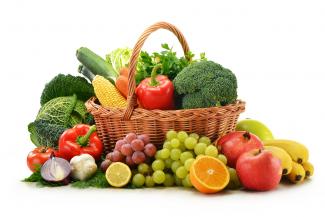
Dr Gita Mathai , a paediatrician and family practitioner, tells us what may be lurking in fruits and vegetables and how to minimise the risk.
Green, red, yellow, purple... the vegetable and fruits section of your supermarket beckons with its shiny products promising health and wellbeing. But could you be taking in more than vitamins and micronutrients with your four to six servings of fruits and vegetables a day?
Here’s what you could be eating as well:
Pesticides
Why is this used: Farmers use high doses of pesticides when growing crops and storing them to keep them safe from birds, rats, squirrels etc. These compounds permeate the skin of the fruits and vegetables. They keep the produce safe, but they are toxic to insects, mould and humans.
How does it affect us: It affects our respiratory and nervous systems. Some of these products are carcinogenic as well.
Calcium carbide
Why is this used: As fruits ripen naturally, they change colour from green to yellow to orange and red, but the colour may be uneven. To hasten the ripening process and make the fruit look uniformly ripe on the outside, calcium carbide is used.
Calcium carbide is sprinkled on the fruit or placed in packets along with the fruit in a sealed container. A little water is then sprinkled on the produce. As the chemical comes in contact with the water vapour, acetylene gas is released. This ripens the fruits within hours instead of days. This compound is highly inflammable and fire accidents occur. Calcium carbide is usually contaminated with carcinogenic chemicals like arsenic and phosphorus hydride. Fruits ripened with calcium carbide look attractive but do not taste good.
How does it affect us: Calcium carbide is a dangerous, corrosive chemical, plus it has traces of arsenic and phosphorus hydride. It can have serious effects – from upset stomach, ulcers and eye irritation to hypoxia (low oxygen reaching blood and tissues) and lung damage. It also has carcinogenic properties.
Ethephon solutions
Why use it: Ethephon gas is a plant growth regulator used to accelerate the ripening of fruits and vegetables. It is expensive so farmers tend to dip produce into impure and dangerous solutions of the product.
How does it affect us: Ethephon inhibits the enzyme erythrocyte cholinesterase, which is present in all the cells of the body. Ethephon shows toxic effects on contact with skin, ingested or inhaled, with skin irritation, ulcers in the mouth and stomach, and muscle wasting. It is suspected to be a carcinogen.
Oxytocin
Why use it: Oxytocin, a hormone released during delivery, is injected into fruit and vegetables to make them grow faster and larger.
How does it affect us: It affects the nervous system. It acts as a neutransmitter in the brain. It is responsible for the release of milk after delivery by its action on chemicals and neurotransmitters in the brain. When taken by people who are not in the post-partum period it still affects the chemicals in the brain and causes changes in social recognition, pair bonding, and precipitates anxiety, aggression and manipulative behaviour.
Colour, mineral oil, bees wax or shellac wax
Why use these: To make fruit and vegetables look colourful and shiny.
How does it affect us: The colours are toxic and often contain lead and other heavy metals. None of these products are safe for consumption regularly.
How to eat fruits and vegetables safely
- Where possible, try to buy organically grown, pesticide-free fruits and vegetables
- Soak fruits and vegetables for at least 10 minutes in water before cooking or eating
- Removing the skin will reduce pesticide, wax, oil and colour residue but do know that it will also decrease the nutritive value of the fruit and vegetables
- Remove and discard the outer leaves of cabbage, lettuce etc.
- Do not wash fruits or vegetables with detergent as this helps penetration of the pesticide and toxins into the deeper layers
- Many household remedies like salt solution, potassium permanganate solution and ascetic acid (vinegar) are anecdotally believed to remove toxins and pesticides. Their efficacy is not proven. The toxin has often permeated the inner layers and are present in the flesh of the fruit or vegetable itself.






